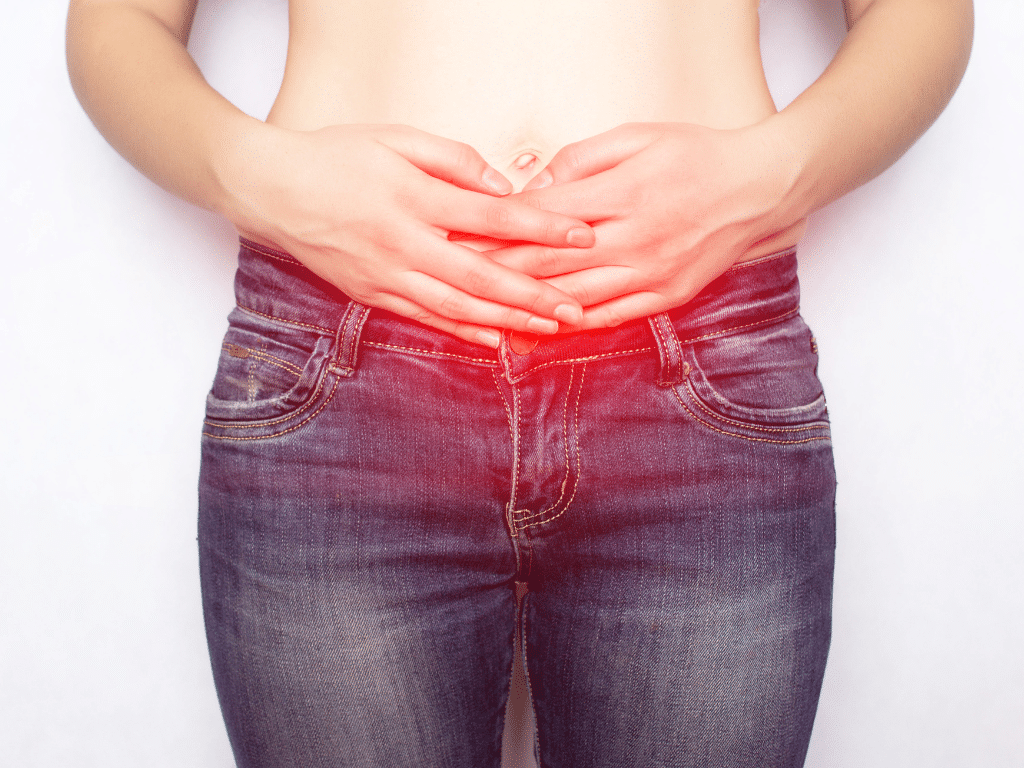What is a Ventral Hernia?
A ventral hernia is a hole that is created in the fascia layer of the abdominal wall. The wall of the abdomen consists of many layers which include:
- Skin.
- Adipose tissue (natural body fat).
- Fascia (Connective tissue layer beneath the skin that protects, supports, and surrounds muscles and internal organs).
- Muscles (internal organs are protected and held in place by your abdominal muscles, they support the spine and maintain posture and core support).
A ventral hernia is a tear in the fascia layer that allows abdominal tissue such as the loop of an intestine to protrude through the weakness in the abdominal wall. The resulting ventral hernia manifests as a bulge that is outwardly visible on the abdomen.
Types of Ventral Hernias
Ventral hernia types are classified by where on the abdomen they are located and include:
1. Epigastric
Epigastric hernias occur in the epigastrium, between the breastbone and navel. Fascia defects cause the formation of these hernias, which occur along the centerline known as linea alba, separating the left and right sides of the abdomen.
A supraumbilical ventral hernia, which forms directly above the belly button, is distinct from an umbilical ventral hernia.
Older adults are more likely to develop ventral hernias, although individuals can also be born with fascia defects that lead to these hernias in this area.
2. Umbilical
An umbilical ventral hernia forms directly within the navel and is a common occurrence in infants and children. Most umbilical ventral hernias typically close naturally by the time a child reaches 4 or 5 years old. However, if the hernia does not close on its own, surgical intervention becomes necessary to repair the affected area.
Although less common, adult men also experience umbilical ventral hernias and require surgical repair. Umbilical hernias can cause pain around the belly button, chronic pressure, nausea, and vomiting.
3. Periumbilical
Unlike a true umbilical ventral hernia, a periumbilical ventral hernia is an indirect umbilical hernia and protrudes above or below the umbilicus and not directly through it like an umbilical ventral hernia.
Periumbilical ventral hernias are frequently observed in adults, particularly older men and individuals with higher body weight. Typical indications of a periumbilical hernia consist of mild or intense sharp discomfort near the belly button, as well as potential enlargement of the hernia.
4. Lateral
Lateral ventral hernias (or Spigelian hernias) are rare and are seen less than 1% of the time. Women are a bit more predisposed to experience a lateral ventral hernia and they can be present from birth or develop later in life. Spigelian or lateral ventral hernias develop more to the left or right side of the abdominal wall and not down the center.
5. Incisional
A ventral incisional hernia occurs when a hernia develops in the same location as a previous surgery scar. Making an incision in the abdomen weakens and compromises the muscles’ strength and integrity. The weakened abdominal muscles are more susceptible to pressure and strain and may allow abdominal tissue or organs to push out through these weakened spots.
What Causes Ventral Hernias?
Congenital ventral hernias may be present since birth, while acquired ones can occur due to chronic pressure or strain on the abdominal muscles. Factors that can create weakened areas in the abdominal muscles and allow ventral hernias to form include:
- Obesity.
- Pregnancy.
- Coughing spells.
- Traumatic injury.
- Lifting heavy objects.
- Prior abdominal surgery.
- Diseases such as diabetes.
- Serious and continued vomiting.
- Chronic constipation/straining from a bowel movement.
Are Ventral Hernias Dangerous?
Some types of ventral hernias do not cause any symptoms and doctors may take a “wait and watch” approach. This would depend on the location and if there were risks of developing an incarcerated hernia.
An incarcerated hernia, also referred to as a strangulated ventral hernia, develops when the protruding tissue or intestine becomes trapped and loses its blood supply, leading to tissue death. Urgent medical intervention becomes crucial in such situations.
How are Ventral Hernias Diagnosed?
Ventral hernias are most often diagnosed by a noticeable protrusion from the abdomen. CT scans, ultrasound, and other forms of testing may confirm the diagnosis.
Is Surgery Necessary to Repair Ventral Hernias?
Ventral hernias normally do not resolve on their own and eventually require surgical repair. Some hernias, depending on their location, will cause discomfort, pain, vomiting, constipation, etc. Patients will seek out treatment to restore their quality of life or their doctor may determine that surgery is necessary, sooner rather than later, to avoid the risk of experiencing a strangulated hernia.
If you are concerned that you may have a ventral hernia or want to understand the key differences between Hernia vs. Hemorrhoids. Check out our informative blog post.
Moreover, you can contact IBI Healthcare Institute. Nonetheless, our team of experts is here to answer your questions and help develop a plan of care that will get your health back on track. Furthermore, you can call us today or set up an appointment online.











